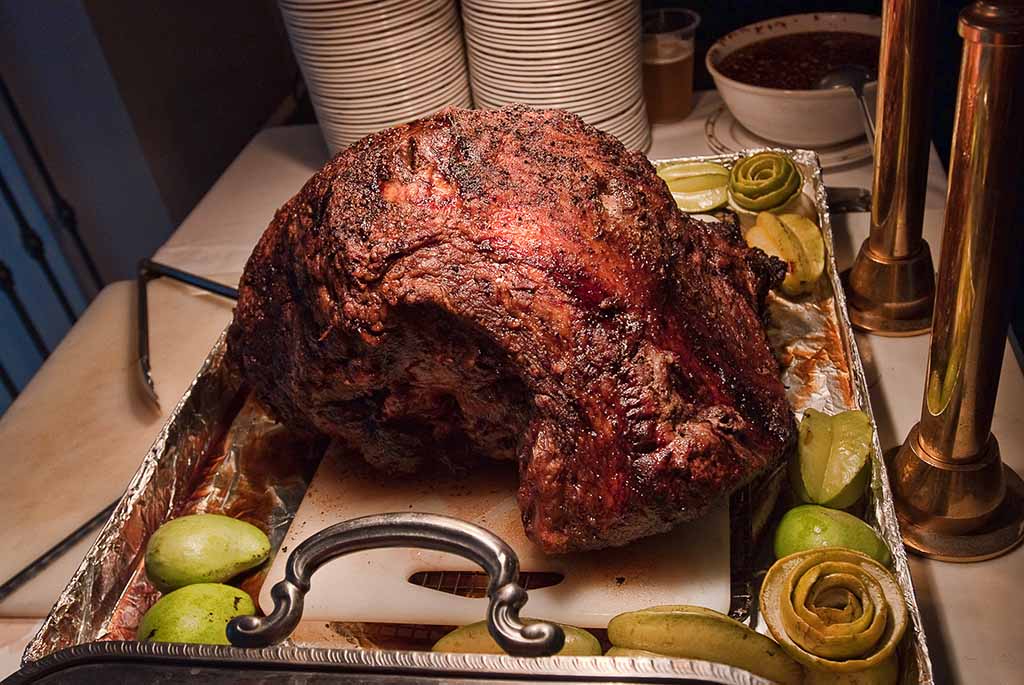Steamboat Round

Description
The steamboat is a round of beef that is roasted whole and is usually carved on a serving line.
History
Origin
Roasted meats have been a standard in many cultures throughout history. In the Mariana Islands, however, the main dietary source for protein came from fish, turtles, birds, and bats, all species native to the archipelago. It is not until the arrival of the Spanish in the 17th century that cattle, pigs and deer, and perhaps chicken, were introduced to the CHamoru people.
The CHamorus consumed meat primarily on special occasions only, preparing most of their beef in stews or soups, called kådo, but they also roasted or baked meat in an oven or over a grill. They were probably also familiar with a variety of beef dishes enjoyed by the Spanish.
During Spanish times, feral cattle roamed the islands of Saipan, Tinian and Rota until the Germans colonized the islands and claimed the cattle as government property. The Germans attempted, but were unable, to establish a commercial cattle industry in these northern islands. Indeed, most cattle raised by CHamorus in Guam and the northern Marianas prior to World War II were utilized for draft purposes, milking or riding. Many of these animals, however, were slaughtered to feed both American and Japanese military and civilians during and after the war.
As with the Germans, attempts to mix local cattle with other breeds imported by the US Navy and later, the US Agricultural Station, had mixed results. Brahma cattle, more easily adaptable to the island’s warm weather and resistant to ticks, proved some success as meat and draft animals, though they did not produce much milk. After World War II, imported beef and tins of meat became more readily available.
Evolution
The American families living on Guam prior to World War II probably introduced the most popular way of preparing roast beef today, with a simple rub of salt and pepper and roasting in an oven. CHamoru men who were enlisted in US Navy as mess attendants (cooks) may have also possibly brought these recipes of meat preparation home.
The emergence after World War II of indoor kitchens with gas or electric ovens that could handle the roasting of large portions of meat, allowed for roast beef, hams and turkeys to eventually become more prominent features of the fiesta or holiday table. The steamboat round, however, is still reserved for the most special of celebrations, and a separate carving station at a large wedding reception or banquet for the steamboat is a common sight.
Preparation
The steamboat is a round of beef that is roasted whole and is usually carved on a serving line. Because of the expense and elegant presentation of a steamboat round, this roast beef is considered a luxury or a prestige item that is served on the most special of occasions, such as wedding receptions, banquets and buffets. The steamboat round of beef should not to be confused with the Asian steamboat or hotpot (stock pot).
The steamboat is derived from the cut of beef referred to as the round, which is at the rump or rear leg of the animal. A classic steamboat would consist of the whole roasted leg, including the top round, bottom round, eye of round, the knuckle and the rump still connected together. These cuts represent the muscles that surround the femur (or thigh/shank) bone. The steamboat can be presented with the shank bone-in, or boneless.
Placement on table
The steamboat round usually is placed separate from the other food items of the fiesta table, in its own “carving station.” A chef carves the steamboat for each diner, who may request a particular portion based on cooked stages, from rare to well-done. A roasted pig, ham and turkey may be found nearby as these luxury meats would be grouped together.